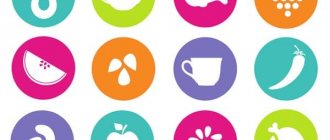How many grams should a serving of food be when losing weight is one of the key and most important questions when creating a diet. Without proper determination of the weight and composition of a single portion, the frequency of meals, even the most active workouts and intense physical activity will not give the desired result in the form of extra pounds lost.
At first glance, the simple procedure for calculating the weight and quality composition of a single serving of food has many nuances and pitfalls, which will be discussed in this article.
How many grams of food to eat when losing weight
Portion rate
How to calculate the number of grams per person per day
In order to find out the daily food weight necessary for the normal functioning of the body and getting rid of extra pounds, you need to perform the following calculations:
- Calculate the daily kilocalorie requirement (DK) required by the body. To determine the value of this norm for men and women, the Mifflin-San Geor formula is used:
DNA for males = (9.99×M) + (6.25×H) + (4.92×Age) + 5;
DNA for women = (9.99×M) + (6.25×H) + (4.92×Age) – 161,
Where:
- M – body weight, kg;
- H – height, cm;
- Age – age, full years.
- Multiply the resulting daily calorie intake by the correction factor (Ka), which takes into account the degree of human activity.
Correction factor Ka taking into account human activity
| Activity level | Correction factor, Ka |
| Sedentary work, inactive lifestyle | 1,2 |
| Light physical activity (daily exercise, walking 2-3 times a week) | 1,4 |
| Regular training (2-3 times a week), active lifestyle | 1,6 |
| Active sports (daily workouts), heavy physical activity at work | 2 |
- Reduce the resulting value by 10-20% - by reducing the daily requirement of kilocalories by only 10-20%, a person does not cause much damage to his body and provokes him to lose weight and gradually lose extra pounds. To calculate the amount of daily kilocalories required for weight loss (DNA for weight loss), the value obtained as a result of the two points above is multiplied by 0.9-0.8.
- The resulting kilocalorie values must be divided into 4-5 meals, taking into account the prepared diet and the energy value of the foods included in it, and calculate their weight for each meal.
Calculation example
Calculation required
Initial data:
- The subject is a 35-year-old woman weighing 70 kg and height 165 cm (1.65 m), leading a sedentary lifestyle (office worker).
- The optimal BMI is the body mass index, equal to the ratio of a person’s weight to the square of his height, for women of a given age is 22.95.
Calculation:
- Using the value of the optimal BMI (22.95), normal weight (Mnorm) is calculated for this age and height:
Mnorm = BMInorm.× Height2 = 22.95 × (1.65 × 1.65) = 62 kg.
On a note. Accordingly, the excess weight value is 70-62 = 8 kg.
- The daily calorie requirement (DNA), calculated using the Mifflin-San Geor formula, taking into account the coefficient taking into account human activity (Ka), for such a woman will be equal to:
DNA=((9.99×70)+(6.25×165)+(4.92×35)-161) × 1.2=2090 kcal.
- To lose weight without harm, such a woman needs to reduce her calorie intake by 20% per day. Accordingly, the daily calorie intake for weight loss (DNA for weight loss) for her will be 2090 × 0.8 = 1672 Kcal;
- If we divide this daily norm into 5 meals, it turns out that at one time this woman can eat foods with a total energy value of 334 Kcal. So, with this calculation, breakfast should consist of 150 g of low-fat cottage cheese (234 Kcal), green tea without sugar (0 Kcal) and 2 large oranges weighing 250-300 g. (approximately 100 Kcal). Thus, a single portion consumed for breakfast in grams for weight loss will weigh only 400-450 grams.
- Daily consumption of the above-mentioned amount of kilocalories and following a diet will allow you to get rid of extra 8 kg in 1.5-2 months, with a healthy loss of 150-200 g of excess weight per day.
This simple method of calculating the amount of food without going to specialists will allow you to independently calculate how many grams you need to eat in order to lose weight and not “make money” as a result of unnecessary illnesses in the form of digestive disorders and too much weight loss below the permissible value.
Important! To lose weight, you need a properly formulated diet, not starvation.
With a complete refusal of food, the body, contrary to the expectations of many, does not burn excess fat, but first of all depletes muscle tissue. This leads to disruption of many functions of the gastrointestinal tract, causes a decrease in the strength of bone and cartilage tissue, and in the most advanced cases contributes to the development of dystrophy and growth retardation.
Serving size for proper nutrition
Serving size for proper nutrition. The basis for losing weight and maintaining health is not only a certain diet of foods, but also the serving size for proper nutrition, which is recommended to be consumed at one time.
Serving size for proper nutrition
proper nutrition
To lose weight without starving, you need to learn how to measure the required amount of food by eye. The serving size can be determined visually, without the use of scales or other devices. This is necessary in order not to overeat and keep your figure slim and your health in excellent condition.
Proper or healthy nutrition is the intake of food that can ensure growth, full development, vitality and excellent well-being for a person.
If you follow the rules of a healthy diet and combine them with physical activity, the risk of chronic diseases and health disorders that lead to the development of obesity, diabetes, hypertension, heart pathologies and vascular diseases, and oncology is reduced.
The benefits of proper nutrition are obvious.
Eating balanced food will put the body in order in a short time and it will be difficult not to notice.
In this case, the following changes occur:
- Reducing cholesterol and restoring normal blood pressure.
These pathologies lead to heart attack and stroke, so reducing animal fats and salt normalizes cholesterol levels and blood pressure.
- Skin cleansing.
If there are rashes on the skin, then proper nutrition can improve the condition of the skin, clear acne, and make the color natural.
- Increased energy levels.
Eating healthy foods can boost your energy levels and improve your overall well-being.
- Improved heart function.
Reducing the consumption of foods containing a lot of animal fats, salt and carbohydrates will improve the functioning of the heart muscle.
- Longevity.
A healthy diet can prevent many diseases, improve the quality of life and, as a result, lead to a long and happy life.
- Normal weight.
Basically, the desire to maintain a normal weight contributes to the transition to proper nutrition.
A diet consisting of eating whole foods and avoiding processed foods, fast food and other crap will maintain a healthy weight and reduce the risk of disease.
- A slim body.
A beautiful figure depends on training and what a person eats. Eating the right amount of fats, proteins and carbohydrates has as much effect on a fit figure as exercise.
According to nutritionists, the transition to proper nutrition can occur at any age, but it will still benefit the body and improve its health.
How to Determine the Correct Portion Size for a Healthy Diet
During a meal, you need to know exactly that the amount of food you need is such that you are not hungry and at the same time do not eat too much.
If you have switched to proper nutrition in order to lose weight, you should not overload your stomach.
But it’s impossible to weigh every portion of food, especially since you don’t always eat at home. Therefore, it is necessary to determine the volume of food visually and there are two ways to do this.
Simple method
Your fist will help you find out the required weight of food and its volume; this is exactly the size of your empty stomach. To avoid stretching or overloading it, you need to fill it just enough.
After eating the main portion, you need to stop taking anything else from the table and chewing. No need to take a supplement. It is better to immediately put pots and pans with food in the refrigerator.
Exact method (in grams)
This method of measuring food is much more difficult. It allows you to accurately find out the weight of a portion without using a scale.
Serving size for proper nutrition
You need to know the following:
- A woman's palm is equal to a piece of chicken fillet or fish weighing 100 grams.
- A woman's fist is 200 grams. meat or fish.
- The phalanx of the thumb is 5 g. oil or half a teaspoon.
- A tablespoon contains 10 g.
- A handful of a woman’s hand is 2 tablespoons of liquid or a serving of salad, porridge or pasta.
Nutritionists give advice on what you need to eat at one time and as much as your hand allows:
Protein food - the size of one palm Vegetables, fruits and salad - the size of a fist Complex carbohydrates - no more than one palm A tablespoon or the length of two phalanges - so much oil in the bowl
In order to gradually lose weight and not deteriorate your health, the daily intake must be reduced by 500 kcal from what a person needs.
If we are guided by the presented principle, then for normal life a person needs
- 2 palms of protein food,
- 1 carbohydrate,
- 3 fists of salad, vegetables or fruits
- 1 phalanx of fat.
To avoid feelings of hunger, you are allowed to eat an additional vegetable dish.
Since when you sit down at the table, you will not measure out food with your palms and handfuls, you should know how to do this with a spoon and glass:
- A woman's fist is similar in size to a glass.
- Soups without grounds are measured in a glass - this will be approximately 200 g.
- Vegetable salads - one glass corresponds to 150 grams. It is better to measure salads with a spoon - 4 spoons will be a portion of 150 g.
- There is no more than 100 grams of mashed potatoes, which is 3-4 spoons.
To correctly measure the serving size of soup with proper nutrition, do not measure it with a glass or spoon.
To do this, you need to determine the volume of the ladle in your kitchen and pour yourself the correct portion. Here it should be noted that various soups in a healthy diet should be the main thing on the table.
Healthy eating is being practiced for different purposes.
To lose weight, you not only need to limit yourself to certain foods, but also perform various physical exercises.
To lose weight with proper nutrition, you should know:
- The diet should be dominated by protein foods or slow carbohydrates.
This must be chosen by your body. To do this, you need to test: eat more protein food one day a week, and a week later slow carbohydrates throughout the day. Depending on your condition and weight in the morning, you can understand what is best for losing weight.
- Replacing fast carbohydrates with slow ones.
It is important to know that fast carbohydrates are found not only in cakes and chocolate, but also in dumplings, cutlets and alcohol. By replacing them with other foods with complex carbohydrates, you can safely eat them and lose weight.
- There are only natural products.
Canned foods with various additives and enhancers are high in calories and do not so much satisfy hunger as oversaturate the body with harmful substances and empty calories.
Using various recipes, you need to cook yourself from natural products from the market.
To gain muscle tissue, you need to eat right and train hard.
Proteins, fats, and carbohydrates are important for muscles, but it is important to distribute them correctly.
How to do it:
- Squirrels. Per day, especially if there is training, the body should receive from 200 grams. or more proteins, at least 30% of the total nutrition
- Carbohydrates . Take only slow ones. They will provide the body with energy for a long time, which is very necessary for training. They must be at least 60%
- Fats . The body also requires them, but these should be mainly products of plant origin. Their need in the body is small, but should be from 5 to 15%
- To prevent dehydration and speed up metabolism, you need to drink a lot of plain water, natural vegetable and fruit juices, and green tea.
Features for women and men
The proper nutrition menu is compiled depending on gender and age. Different sexes have different metabolic rates; men have a faster metabolism, and they burn calories almost immediately.
When developing a menu, you should take into account not only caloric content, but also include different products.
The menu for men is compiled in compliance with the following rule - it is necessary to include in the diet more protein, high-calorie foods, as well as foods rich in selenium and zinc.
The principle of compiling a women's menu is the following: fewer calories and more vitamins.
The fair sex requires:
- unsaturated fatty acids;
- collagen;
- antioxidants;
- calcium.
At the beginning of the transition to healthy food, it can be very difficult - the food seems tasteless because it is bland.
But, gradually, with improvement in well-being, addiction will set in, lightness will come, and harmful foods will simply be forgotten.
Also, people who switch to a healthy diet complain about the constant presence of hunger. This is due to the distension of the stomach. Therefore, the number of servings should be reduced gradually.
Share on social media networks
Tags: consumerServing size
How much can you eat at one time?
How many carbohydrates do you need per day when losing weight?
You can calculate what single servings you should have in order to lose weight using two methods:
Portion has limitations
- With the help of hands (palms, fists, fingers) - it is generally accepted that the human stomach is equal in volume to two of its fists. Therefore, in order not to stretch or burden it during the meal, many people measure a single portion using their fist, palm or fingers. For example, a single serving of meat or meat products should be no larger than the size of a palm without fingers. Vegetables and herbs consumed in salads or fresh at one time should be placed in two palms folded together. Fruits consumed at one time (oranges, apples, peaches) should have a volume equal to or slightly less than that of a hand clenched into a fist. In this way, you can very quickly and quite accurately calculate how much of certain foods you can eat at one time.
- By weight - this method allows you to determine which product and in what exact quantity should be consumed during one meal. In this case, using the above method, the daily requirement for kilocalories for weight loss is calculated, a diet of 4-5 meals a day is drawn up, the total calorie content of individual meals is divided between the products included in them, after which the weight of individual products is calculated using tabular data. The calculated amount is weighed using good electronic household scales with an accuracy of 0.1 g. This method allows you to eat exactly as much as was calculated. Compared to the previous one, its disadvantages are the large amount of time spent weighing products and the mandatory presence of fairly accurate scales.
Important! When asked about what portion of food an adult should have to lose weight in volumetric terms, many doctors and nutritionists answer - no more than 200-250 ml.
With this amount, the stomach is not overloaded and digests food most efficiently.
Human stomach: stomach volume and functions
To understand how much you can eat, let’s look at the normal volume of the stomach and its functions.
Focus on volume
your
stomach
:
the volume
of food and liquid at one time should be 2/3
of the volume
of your
stomach
.
Since the food consumed should not stretch the stomach
.
It is also necessary to take into account not only how much
, but also
what
we eat.
The main function of the stomach is to store and partially digest food. This process is carried out thanks to the complex interaction of the stomach and other organs of the digestive tract. This interaction is carried out through nervous and humoral regulation. A bolus of food consisting of chewed food and saliva enters the stomach through the esophagus. Food masses remain in the stomach for 1.5 - 2 hours.
The volume of the human stomach before eating is approximately 500 ml. When filled, it can increase to four liters, but on average the filling occurs up to one liter.
Keep in mind that this volume also includes liquid. However, the size of the stomach can also depend on the body type and individual characteristics of the body. An empty stomach reaches 20 cm in length, with the front and back surfaces touching each other, a full stomach stretches to 24-26 cm, the walls move away by 8-9 cm.
How often to eat while losing weight
What nuts can you eat while losing weight?
When losing weight, you need to eat fractionally, dividing your daily food requirement into 4-5 meals. Also, for the normal functioning of the body in the intervals between meals, it is necessary to drink a lot of liquid: simple purified drinking water, green or black tea without sugar. Moreover, all food consumed should not contain preservatives, GMOs, harmful additives, or flavor enhancers. Also, in order to lose weight, proper nutrition must be combined with physical exercise, going to the gym, or if there is not enough time, morning exercises or jogging.
Important ! When losing weight, you should never “take bites” - eat anything after or before meals. This habit, more typical for young children, not only suppresses appetite, but also negates the benefits of the diet. Also, when losing weight, you should exclude from your diet all alcohol (beer, champagne, wine), carbonated and energy drinks, flour, sweets, processed foods, fast food (burgers, fries, hot dogs, etc.).
Eating more frequently does not help fight hunger, but increasing your protein intake does.
Many people may say that eating more often makes them feel less hungry, but studies have not found a correlation between the number of meals and snacking [17], or at least a positive one [18, 19].
However, a connection between satiety and higher protein consumption has been found—proteins leave you feeling full longer [18, 20]. And, as a rule, those who eat more often simply eat more protein foods, and therefore feel less hungry. But what prevents you from eating less often, but with a higher proportion of protein? But just replacing “carbohydrate” snacks with protein can change the results of studies on food frequency [21].










